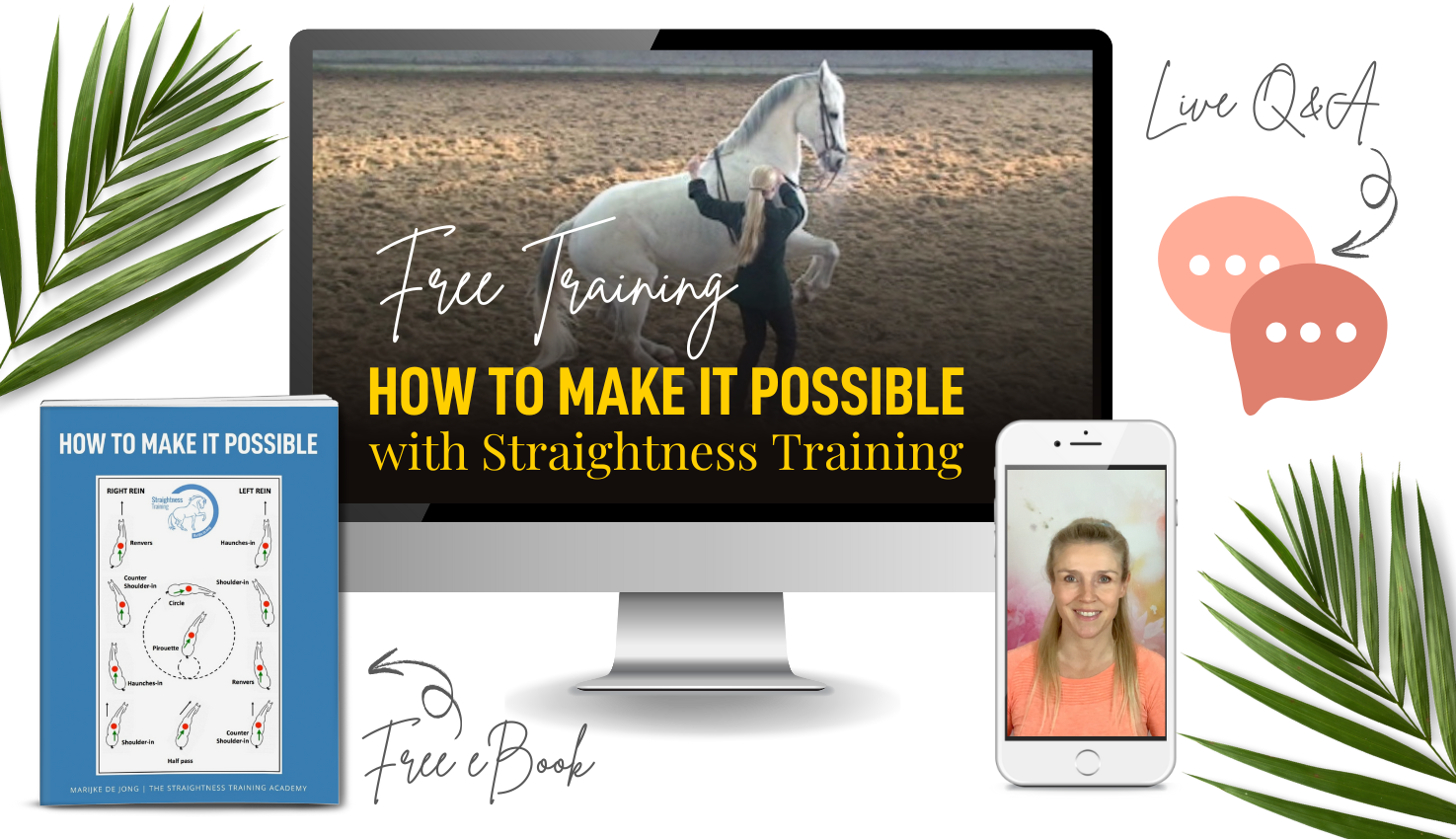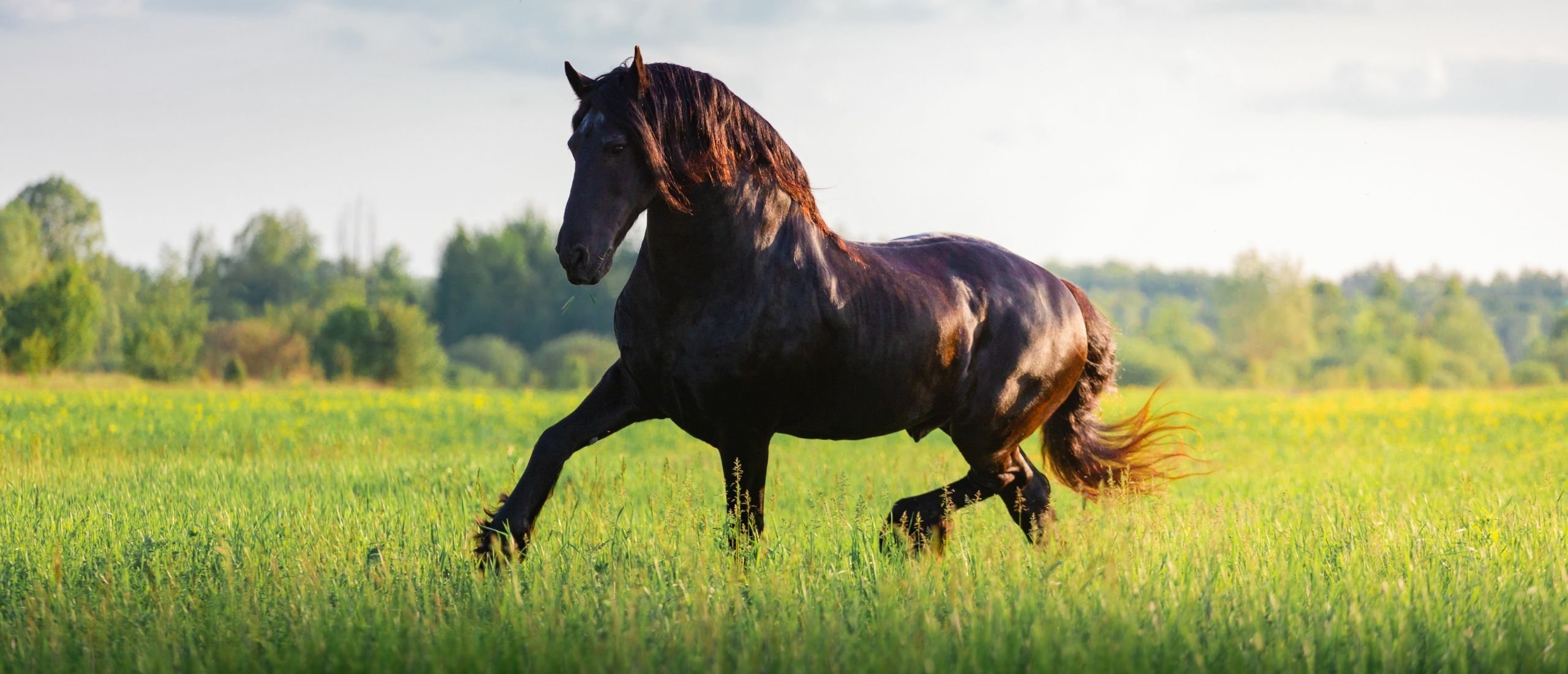
Horse gaits & Gaited horses
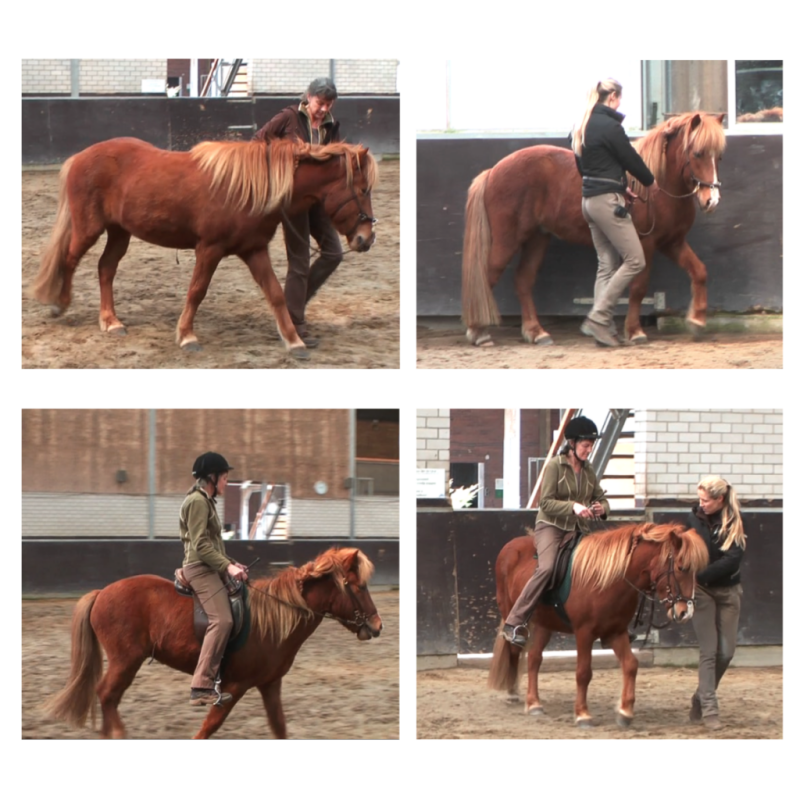
A frequenly asked question is: “Can I do Straightness Training with my gaited horse?”
The answer is: yes! And I will tell you why in the article below.
Now when it comes to gaits the horse we can speak about the following gaits:
- Natural gaits
- Artificial gaits
- Falce and disunited gaits
- Defective gaits
- Ambling gaits
1. Natural gaits
Horse gaits are the various ways in which a horse can move. The natural gaits of a horse are:
Walk

The walk is the least elevated, slowest and gentlest action of all the gaits. The walk is a four-beat gait. When walking, a horse’s legs follow this sequence: left hind leg, left front leg, right hind leg, right front leg, in a 1-2-3-4 beat. At the walk, the horse will always have one foot raised and the other three feet on the ground.
Trot
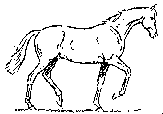
The trot is a two-beat diagonal gait. A horse trots by lifting two diagonally opposite legs at the same time: the left hind leg together with the right front leg and the right hind leg together with the left front leg. There is a moment of suspension in which there are no legs on the ground.
Canter
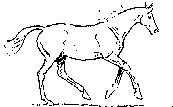
The canter is a three-beat gait with a moment of suspension. A horse can canter to the right where the right fore leg leads, and to the left (demo picture), where the left shoulder leads. In the right canter the left hind leg propels the horse forward. In the left canter (demo picture) the right hind leg propels the horse forward.
Gallop
The gallop is the fastest gait of the horse and more ground-covering then the canter. In the gallop the three-beat canter changes to a four-beat gait. In the wild the canter is used when the animal needs to flee.

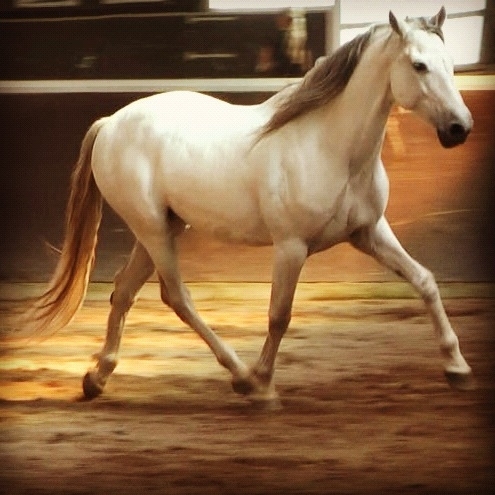

2. Artificial gaits
Artificial gaits are derived from the natural gaits and are a result of specialized training by a skillful rider. Artificial gaits introduced to the horse to educate and strengthen the horse:
- Piaffe, a trot on the place without advancing or backing.
- Passage, a cadenced ‘slow motion’ trot in which the horse must prolong the time the legs are off the ground.
- Pirouette, a canter on a circle where the croupe stays in the center on one spot.
- Levade, in which the horse’s forelegs are raised and his haunches are bent.
- School jumps, where a horse jumps in the air to perform a high air like the capriole.
3. False and disunited gaits
False and disunited gaits (which often arise because of natural asymmetry) are:
- The false canter or canter on the wrong lead, where the horse leads with the outside foreleg instead of the inside.
- The disunited canter, either before or behind. When disunited in the front, only the hind legs are moving in correct order (for example to the left, the hind legs are in the left lead en the front legs are moving in the right lead). When disunited in behind, only the front legs are moving in correct order.
4. Defective gaits
Defective gaits are often are found in horses with natural weaknesses or in horses that are old and run down.
A defective gait is for example when the forelegs of the horse canter and the hind legs are trotting. This is also called the ‘rack’ or the ‘tranter’.
Also former racing trotters show this tendency, to canter in front and trot in behind, once they are asked to perform the canter.
5. Ambling gaits
Gaited horses are horse breeds that have ability to perform one of the smooth-to-ride, intermediate speed, four-beat horse gaits, called ambling gaits.
Such breeds include:
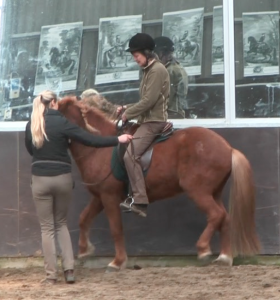
- Icelandic horse
- Paso Fino
- Peruvian Paso
- Tennessee Walker
- Mangalarga Marchador
- Campolina
- Aegidienberger
- American Saddlebred
- Campeiro
- Pampa
- Racking Horse
- Marwari horse
- Messara horse
- Standardbred
- Walkaloosa
- Florida Cracker Horse
- Missouri Fox Trotter
- North American Single-Footing Horse
- Rocky Mountain Horse
- Spotted Saddle horse
The names of the special gaits of gaited horses derive from differences in footfall patterns and speed, they are collectively referred to as the “amble.”
Some of these breeds are ‘five gaiters‘, like the Icelandic horse, the Paso Fino and the American Saddlebred, because they can not only move in walk, trot and canter but also in two other ambling gaits.
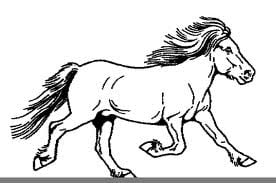
All ambling gaits are faster than a walk but usually slower than a canter.
- The (stepping) pace is a slow lateral gait where the front and hind leg on the same side are simultaneously raised carried forward, and set down together. To pace well the haunches must be carried low and well bent.
- In the flying pace there is a moment of suspension. Horses that are ruined in the back will also perform this gait, than it’s called a defective gait.
- Many South American horse breeds have a range of smooth intermediate lateral ambling gaits. The Paso Fino’s speed variations are called (from slowest to fastest) the paso fino, paso corto, and paso largo.
- The Peruvian Paso’s lateral gaits are known as the paso llano and sobreandando.
- The lateral gait of the Mangalarga Marchador is called the marcha picada.
- The tölt is a four-beat lateral gait in which there is always at least one foot on the ground. There is no moment of suspension. When a horse is doing clean tolt, it is doing the same footfall as in walk. The difference is that in walk a horse is standing on 3 feet once in a while, when a horse is standing on only 1 foot in tölt. This gait is very unique to the Icelandic horse, but some breeds of horses that are related to the Icelandic horse, living in the Faroe Islands and Norway, also tölt. A proper educated tölt is at the same level of the piaffe, because all 6 keys of Straightness Training needs to be there.
- The single foot is a slow and broken gait, and breeds like the Tennesee Walking horses can perform this gait by nature. Some horses who have legs that are worn out or spoiled will take this gait too, but when non-gaited horses moves like this, then it’s called an imperfect or defective gait.
- The running walk a is a four-beat lateral gait with footfalls in the same sequence as the regular walk, but characterized by greater speed and smoothness. It is a natural gait of the Tennessee Walking horse.
- The fox trot is a four-beat diagonal gait in which the front foot of the diagonal pair lands before the hind. This gait is most often associated with the Missouri Foxtrotter breed, but is also seen under different names in other gaited breeds.
- The (lateral) rack is a lateral gait most commonly associated with the Five-Gaited American Saddlebred. In the rack, the speed is increased to be approximately that of the pace, but it is a four-beat gait with equal intervals between each beat.
- The revaal or ravaal is a four-beat lateral gait associated with Marwari, Kathiawari or Sindhi horse breeds of India.
Is ST useful for gaited horses?
No matter what breed, people who love horses, really all want the same;
- They are always looking for a good mental connection with their horse.
- And they are looking for a light, soft, willing, calm and balanced horse that is a pleasure to ride.
Since every horse is asymmetrical by nature, also the gaited horses has to be ‘straightened’ to be able to move in a supple and balanced way.
No horse is made to carry a rider – no matter what breed, no matter if it’s a gaited horse or not – because by nature most weight is on his fore legs because of the heavy head and neck. The hind legs pushes the body forward and when the weight of a rider is placed on the horse, it overloads the fore legs even more. And the fragile front legs can be easily overstraint because of the overload.
Therefore we need to educate and train a horse to transform the ability from the hind legs from ‘pushing’ ability to also ‘carrying’ ability. To carry a rider properly and without harming the front legs or back, the horse should carry the weight of his own body and that of the rider mainly with his hind legs. Because when the use of their hind legs is not equal and their weight distribution on the front legs is not equal, they will perform all gaits in an imbalanced way.
For example if you can tölt easily to the left but not to the right with your Icelandic horse, or when he’s very weak in the hind legs, so your tölt is of poor quality, you know you need to strengthen and straighten your horse.
Because an imbalanced Icelandic horse who has a hard time engaging in the different gaits, will start to move with a hollow and stiff back, with too much weight on the front legs. And a hollow and stiff back and the feeling of a ‘hard mouth’ is not comfortable for both horse and rider:

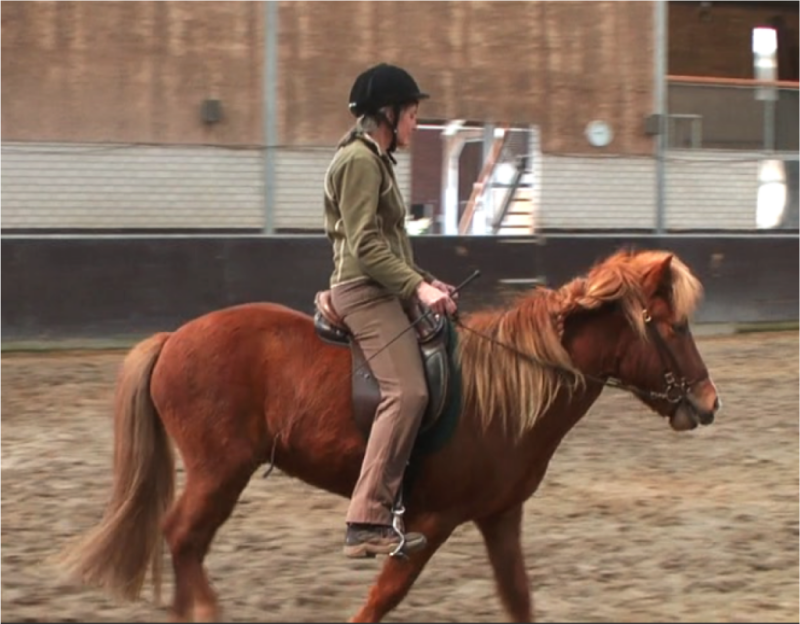
With Straightness Training you can help the horse to shift the weight more back and to free the shoulders and lift the back to be able to carry a rider properly. By addressing all 6 keys of Straightness Training in the training of your gaited horse, you can supple his back and his hind legs, so he can carry himself and the rider in a healthy and balanced way:
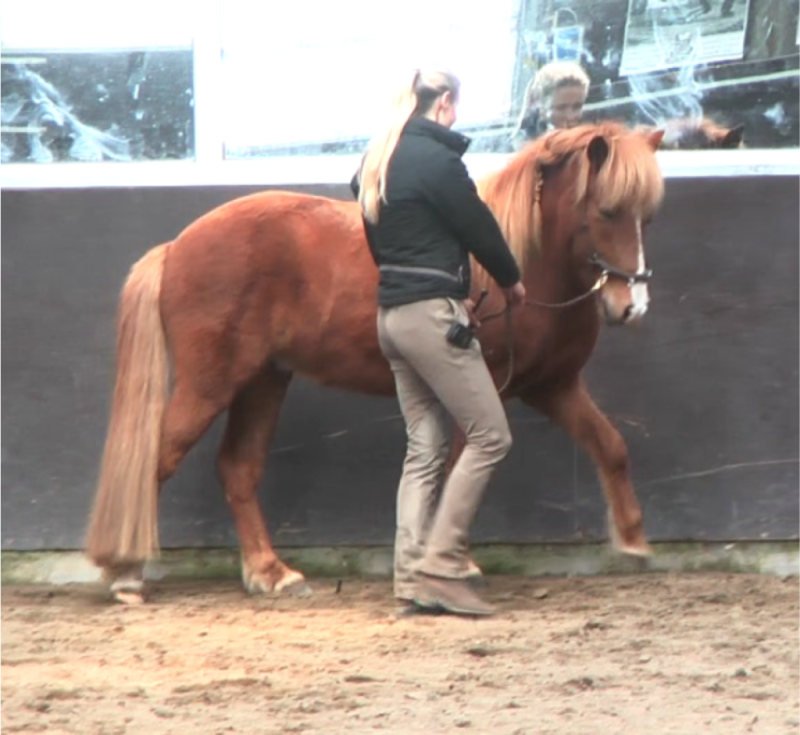
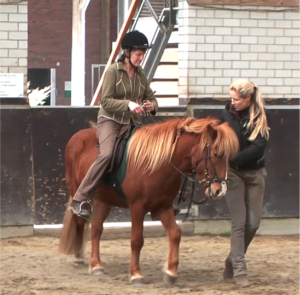
With ST you are able to achieve the ideal of a connected, light, willing, calm and balanced horse that is a pleasure to ride, in whatever gait you want to ride, so you can perform at your best in your own discipline.
Common gait issues
Without proper education you could end up for example with a tölt where the horse is just moving with a high position of head and neck without lowering of the hind quarters, and this will stiffen the back or the horse will drop his back, and he will carry too much weight on the front legs. Because without proper schooling, the hind legs may not have developed the carrying ability which is necessary to carry a rider.
Then all kind of issues might pop up:
- A hard mouth or tongue over the bit because of a stiff, short, contracted, or dropped back.
- Spine issues because of a stiff, short, contracted, or dropped back.
- Nervousness, because of the tension in the back and the high head carriage.
- Lazyiness or dullness, because of his stiffness.
- Moving with one hind leg next to the body or with both hind legs pushing against the center of mass, ending up with too much weight on the front legs.
- Lack of ‘clean’ tölt, lack of clean 1-2-3-4 rhythm.
- A pacy tölt, where the beat is still four beat, but you hear a two-beat and it the footfalls are nearer to pace.
- A trotty tölt, where the tölt is nearer to trot, because it’s more two-beated than four-beated.
- Rolling, whith a small ‘hop’ in one of the front legs, so it looks like the horse is about to canter, because he takes larger steps with his stronger side.
- Piggy-pace, where the horse is very stiff and the rider is thrown from side to side in the saddle.
- Mixing gaits because of tension.
The cause is that the horse is not straightened enough, he is still asymmetrical, he is weaker to one side thann the other, he is not evenly stretched to both sides in the lateral bend and he’s not evenly supple and strong in the hindquarters, so he’s not athletic enough.
Think first, act later
Now if you for example have a tölt issue with your horse, it’s not a good idea to address and solve tölt problems in the tölt. Remember Einstein’s definition of insanity: doing the same thing over and over again and expecting different results .
It’s better to think first, act later:
- So first define the asymmetry: define to what side the horse bends more difficult and which hind leg is the stiffest.
- Then practice the circles and lateral movements in walk to solve this asymmetry. Because in circles, shoulder-in and haunches-in the horse is able to stretch one side of his body and to train one hind leg separately, which makes us able to isolate a weak part of the horse and to train it separately.
- Then start to collect in walk and train circles and lateral movements in trot, to get the horse more athletic and sure-footed and to end up with more relaxed and free movements.
- When alll exercises are performed in a supple way and the horse is soft and subtle to your aids, start making transitions from a collected walk into a collected tölt.
So just follow the 6 Keys of ST to solve any kind of issue with a gaited horse.
The 6 Keys of ST with a gaited horse
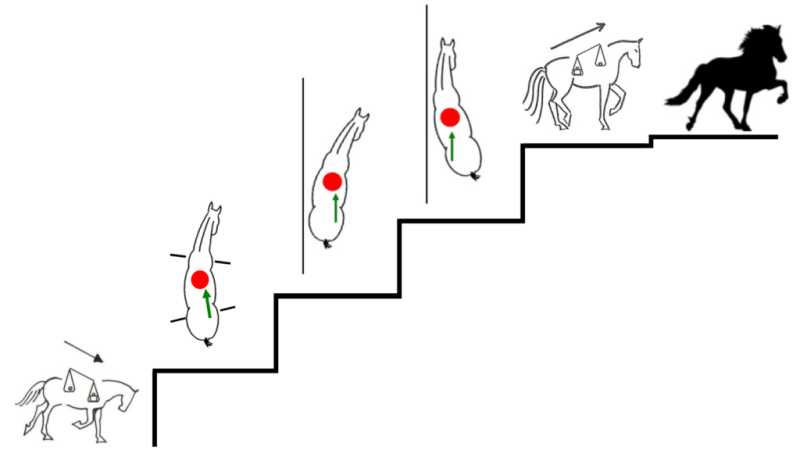
The first thing to do with an asymmetrical gaited horse, that carries most weight on the front legs, is to create a proper LFS on the circle.
- With L, we mean lateral bending of the spine. By stretching short muscles and contracting long, weak muscles, the horse can bend laterally to both sides. This is Key #1.
- With F, we mean the forward down tendency of the head and neck, which is a result of relaxed and stretched back muscles. This is Key #2.
- With S, we mean the stepping under of the inside hind leg as a result of a correct lateral bend and correct positioned center of mass.This is Key #3.
Now a lot of people with gaited horses might probably think that doing fancy exercises as ‘shoulder-in’ and ‘haunches-in’ is only something for dressage horses. But we should think beyond the names of the exercises and know the reason why these exercises exsist: Shoulder-in and haunches-in school the inside – Key #4 – and the outside hindleg – Key #5- to step in under the center of mass. The result is that the horse has to bend the joint of the carrying hind leg more because it will take more of the horses weight. And that makes the hind leg more supple and strong.
When both hind legs are supple and strong and can carry the horse in the lateral movements in walk and trot, you can start to collect a horse and you can start doing exercises where both hind legs has to carry the weight – Key #6.
Exercises to collect a gaited horse are for example the piaffe, pirouette and tölt. In all exercises the horse should be in a collected, round energy and frame and with lowered hindquarters. The difference between piaffe, pirouette and tölt is mainly the beat: the piaffe is a diagonal two-beat, the pirouette a three-beat, and the tölt is a four-beated collection.
So if you collect a gaited horse, you should be able to ask for a two, three, or four-beated collection:
- When you ask for a two-beat you’ll end up with collected trot, which is the piaffe (more on the place) or passage (more forward).
- When you ask for a three-beat you’ll end up with collected canter.
- When you ask for a four-beat you’ll end up with a collected tölt.
When you have developed a horse all the way to collection, you should be able to communicate on a high level too, so you are able to ask for all three variants in collection.

